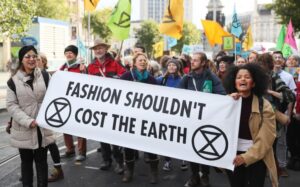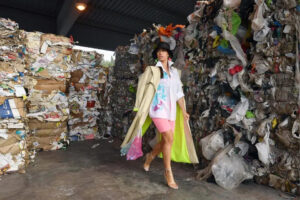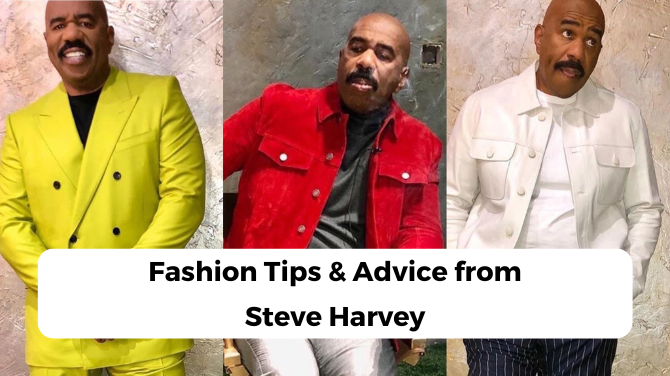Slow fashion is a philosophy that advocates for a slower approach to consumption.
This can mean slowing down the production process, being mindful of your consumption habits, and taking steps to reduce waste in the fashion industry.
Why should I be interested in slow fashion?

The world is experiencing rapid growth in the number of consumers and their desire for more products.
This has led to an increase in overproduction, which results in mass consumerism, pollution, and the destruction of natural resources.
While there are over 6 billion people in the world, we have only 1 Earth to sustain them all.
The best way to avoid this problem is to use a circular economy, which is one that reuses materials and components of products instead of simply discarding them after they’ve been used.
A circular economy can help address issues such as pollution, waste, poverty, and global warming.
The end goal is to create a closed-loop in which waste isn’t produced.
The problem with a linear economy is that it’s unsustainable, and we’re already seeing the effects of this system.
It leads to environmental degradation, waste, and pollution as we continue to extract more resources from the earth.
There are limits to what we can do on our planet, and if we continue using resources at the rate we are now, we will run out of them eventually.
Another issue with a linear economy is that it’s not very efficient.
If we have to use resources in the same order they were created, then we will end up using them in the most inefficient way possible.
For example, if we grow food on land that requires lots of water and fertilizer, and then use more water and fertilizer to make clothing from the food we grew, it’s wasteful. We can grow food on land that doesn’t require as much water and fertilizer, then use the water and fertilizer we saved to make clothing. We can also grow food in areas that require less sunlight and use the sunlight we save to make clothes. This is a more efficient way of using resources because it minimizes our environmental impact.

In this case, economics does not work for the environment but against it: If there are economic incentives to overuse resources, people will overuse them. But if there are economic incentives to minimize resource use, people will minimize it.
Economics has a role to play in environmental protection, but it is not the only game in town.
In fact, it may be the least important of the three.
Politics and ethics matter as well — indeed, politics and ethics are necessary for sound economics to operate.
But politics and ethics do not operate on their own; they depend on people who understand them, implement them and enforce them.
The trouble is that our current approach is a little like having someone tell you that you have to have a religion, but it doesn’t matter which one.
That isn’t enough.
You need a guide who can help you choose between the options available to you and make sure that whatever you do is properly implemented and enforced.
What does it mean by Minimalistic fashion?
There are many answers to this question.
For one, it is fashion that is characterized by simplicity and comfort.
It doesn’t mean you should go out with just a pair of jeans and a T-shirt or wear a simple white shirt.
Minimalistic fashion simply means wearing only what you need and avoiding all the unnecessary items in your wardrobe.
Minimalism in Fashion Tips:
- Don’t try to be someone else – This means that if you are not comfortable wearing something, then don’t wear it. It doesn’t matter if someone else wears it and looks good in it. What matters is how you feel about yourself when you wear that item.
- Invest in quality – There is no point in buying a shirt for Rs. 1000 if it will be torn up after a few washes or a pair of shoes that won’t last long enough to see you through the season. If you can afford it, buy quality items that will last longer.
- Think before you buy – Don’t just go out and buy something because it is on sale or you think it looks good. Before you buy anything, think about how often you will wear it and if it is worth the money. If you can’t answer these questions, don’t buy it.
- Make the most of your clothes – Learn how to use your clothes effectively and don’t just throw them on the floor when you take them off. For example, hang up or fold your shirts instead of throwing them on the floor, or fold your pants and stack them neatly in a drawer. Also, get rid of old clothes that you never wear anymore – donate them to charity or sell them to a consignment shop.
Conclusion
Slow fashion and minimalistic fashion sense are somewhat similar concepts wrapped in a different cover.
The ultimate goal of each philosophy is to cut back on consumption and buy clothes that are essential.
In a world where people are expected to appear in a different dress each time they appear on social media or at any event, minimalistic fashion can definitely help decrease this pressure on people.
Minimalistic fashion alongside a slow fashion sense is only the way forward for achieving faster sustainability goals.
For minimal design fabrics that are sustainability certified, contact us













